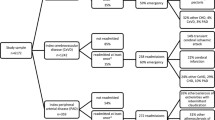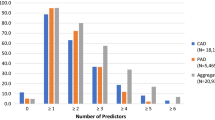Abstract
Background: Peripheral arterial disease (PAD) is increasingly recognised as an indicator of disseminated atherothrombosis, but its impact on use of healthcare resources is not well understood.
Objective: To provide a quantitative description of the resource utilisation and costs incurred following PAD.
Methods: Hospitalisations, physician visits and the corresponding direct medical costs were examined in 16 440 patients with a diagnosis of PAD (1985–1995) in Saskatchewan, Canada, and compared with 15 590 reference patients with a diagnosis of myocardial infarction (MI) [1990–1995]. Medical history and patient characteristics were available retrospectively to January 1980 and follow-up to December 2000. Rates and timing of all-cause and cardiovascular hospitalisations and physician visits within discrete periods in the 10 years following PAD diagnosis, and 5 years following MI, were evaluated, as were lengths of stay and predictors of hospitalisation.
Results: Average follow-up was 5.9 years among patients with PAD and 3.6 years for MI. Half (55%) of patients with PAD were male versus 64% of reference patients. The mean ages were 67.3 and 66.9 years, respectively. Patients with PAD were hospitalised most frequently soon after diagnosis, with rates subsequently decreasing to 0.14 per month. These rates were similar in the reference group except for the period immediately following MI. The average 5-year cost post-diagnosis (2002 $Can) per patient was $Can41 968 vs $Can48 578 for the reference population.
Conclusions: A diagnosis of PAD not only imposes a severe burden on patients and their families, but it also significantly increases the use of healthcare resources and the associated costs. By the end of year 1, this burden is comparable with a diagnosis of MI.







Similar content being viewed by others
References
Criqui MH. Systematic atherosclerosis risk and the mandate for intervention in atherosclerotic peripheral arterial disease. Am J Cardiol 2001; 88 Suppl. 2: 43–7
Criqui MH. Peripheral arterial disease: epidemiological aspects. Vase Med 2001; 6 Suppl. 1: 3–7
Stoffers HE, Rinkens RP, Kester AD, et al. The prevalence of asymptomatic and unrecognized peripheral arterial occlusive disease. Int J Epidemiol 1996; 25: 282–90
Hooi J. Incidence of and risk factors for asymptomatic peripheral arterial occlusive disease: a longitudinal study. Scand J Prim Health Care 1998; 16: 177–82
Weitz JI, Byrne J, Clagett P, et al. Diagnosis and treatment of chronic arterial insufficiency of the lower extremities: a critical review. Circulation 1996; 94: 3026–49
Hirsch AT, Criqui MH, Treat-Jacobson D, et al. Peripheral arterial disease detection, awareness, and treatment in primary care. JAMA 2001; 286: 1317–24
Criqui MH. Systematic atherosclerosis risk and the mandate for intervention in atherosclerotic peripheral arterial disease. Am J Cardiol 2001; 88 Suppl. 2: 43–7
Weitz JI, Byrne J, Clagett P, et al. Diagnosis and treatment of chronic arterial insufficiency of the lower extremities: a critical review. Circulation 1996; 94: 3026–49
Antithrombotic Trialists’ Collaboration. Collaborative metaanalysis of randomised trials of antiplatelet therapy for prevention of death, myocardial infarction, and stroke in high risk patients. BMJ 2002; 324: 71–86
Howell MA, Colgan MP, Seeger RW, et al. Relationship of severity of lower limb peripheral vascular disease to mortality and morbidity: a six-year follow-up study. J Vase Surg 1989; 9: 691–7
Criqui MH, Langer RD, Fronek A, et al. Mortality over a period of 10 years in patients with peripheral arterial disease. N Engl J Med 1992; 326: 381–6
Vickrey BG, Rector TS, Wickstrom SL, et al. Occurrence of secondary ischemic events among persons with atherosclerotic vascular disease. Stroke 2002; 33: 901–6
Bowlin SJ, Medalie JH, Flocke SA, et al. Intermittent claudication in 8343 men and 21-year specific mortality follow-up. Ann Epidemiol 1997; 7: 180–7
Murabito JM, D’Agostino RB, Silbershatz H, et al. Intermittent claudication: a risk profile from The Framingham Heart Study. Circulation 1997; 96: 44–9
Brown JB, Delea TE, Nichols GA, et al. Use of oral antithrombotic agents among health maintenance organization members with atherosclerotic cardiovascular disease. Arch Intern Med 2002; 162: 193–9
Anand SS, Kundi A, Eikelboom J, et al. Low rates of preventive practices in patients with peripheral arterial disease. Can J Cardiol 1999; 15: 1259–63
Zachry WM, Wilson JP, Lawson KA, et al. Procedure costs and outcomes associated with pharmacologic management of peripheral arterial disease in the Department of Defense. Clin Ther 1999; 21: 1358–69
McDermott MM, Hahn EA, Greenland P, et al. Atherosclerotic risk factor reduction in peripheral arterial disease. J Gen Intern Med 2002; 17: 895–904
Caro JJ, Huybrechts KIT, Klittich WS, et al. Allocating funds for the cardiovascular disease prevention in light of the NCEP ATP III guidelines. Am J Manag Care 2003; 9: 477–89
Malcolm E, Downey W, Strand LM, et al. Saskatchewan Health’s linkable data bases and pharmacoepidemiology. Post Marketing Surveillance 1993; 6: 175–264
Caro JJ, Migliaccio-Walle K, on behalf of the CAPRA Study Group. Generalizing the results of clinical trials to actual practice: the example of clopidogrel therapy for the prevention of vascular events. Am J Med 1999; 107: 568–72
Stergachis A, Sheingold S, Luce BR, et al. Medical care and cost outcomes after pentoxifylline treatment for peripheral arterial disease. Arch Intern Med 1992; 152: 1220–4
The Ontario Case Costing Project. The Ontario Case Costing Program Database 1995–96. Ottawa (ON): Ontario Ministry of Health and Ontario Hospital Association, 1996
The Ontario Case Costing Project. FY 1999/2000 Typical Cases file [online]. Available from URL: http://www.occp.com [Accessed 2002 Feb 28]
Alberta Health and Wellness. Health Resourcing Branch: Health Costing in Alberta, Annual Report, 1999 [online]. Available from URL: http://www.health.gov.ab.ca/public/doe-ument/ar99-00/ [Accessed 2002 Feb 28]
Stegman MS, Aaron WS, eds. St. Anthony’s ICD-9-CM Code Book. Reston (VA): St. Anthony’s Publishing, Inc., 1995
Acknowledgements
This study is based in part on de-identified data provided by the Saskatchewan Department of Health. The interpretation and conclusions contained herein do not necessarily represent those of the Government of Saskatchewan or the Saskatchewan Department of Health.
This work was supported in part by a grant from Sanofi-Synthelabo and Bristol-Myers Squibb to Caro Research. The grantors collaborated in helping set the specifications for the example but had no role in methodological decisions or interpretation of results. They were also allowed to review and comment on this manuscript but were explicitly forbidden from exerting any editorial control. Expenses for travel to present the findings at the European Society of Cardiology Annual Meeting, Vienna, 31 August 2003 were reimbursed. The authors are employees of Caro Research, a consultancy that has also received grants for other, unrelated, research from other pharmaceutical companies.
K. Migliaccio-Walle and J. Jaime Caro conceived the study, designed the analyses and wrote the paper; K. Ishak helped design the analyses, carried out all the analyses and helped write the paper; J.A. O’Brien developed the cost estimates and helped write the paper.
Author information
Authors and Affiliations
Corresponding author
Rights and permissions
About this article
Cite this article
Migliaccio-Walle, K., Caro, J.J., Ishak, K.J. et al. Costs and medical care consequences associated with the diagnosis of peripheral arterial disease. Pharmacoeconomics 23, 733–742 (2005). https://doi.org/10.2165/00019053-200523070-00007
Published:
Issue Date:
DOI: https://doi.org/10.2165/00019053-200523070-00007




